Magh Bihu | Bhogali Bihu Festival
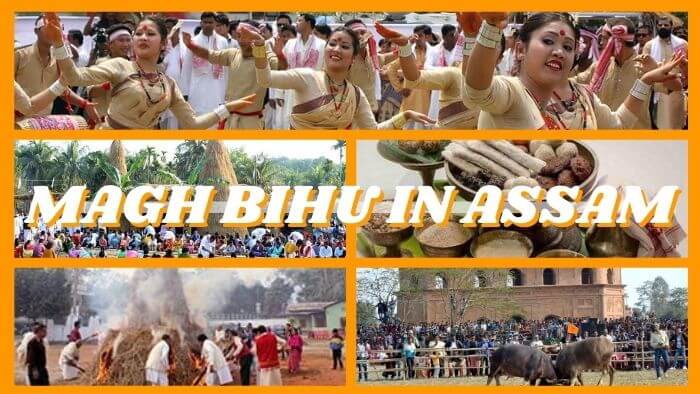
Harvesting festival is widely celebrated in the mid of January month across India with different names and colors. In Assam, it is celebrated as Bihu while Punjab observes it as ‘Lohri’ and the rest of the South Indian states vividly celebrate it as ‘Pongal’. Bihu is Assam’s one of the most important festivals. It is a beautiful festival that sees grand celebrations to welcome the harvest season are in Assam and other northeastern states.
Magh Bihu or Bhogali Bihu (mid-January), is derived from the word ‘Bhog’ meaning ‘eating’ or ‘gratification’. It is the harvest festival that marks the end of the harvesting season. After harvest grains are at the plenty so there is a lot of feasting and eating during this festival. The festival marks Makar Sankranti or the transit of the sun towards the Tropic of Cancer. Many other communities across India also celebrate the same occasion as it marks the end of winter and the beginning of long and warm days.
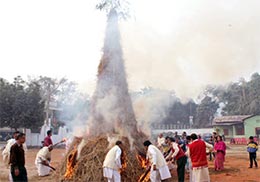
The eve of the Magh Bihu festival is called Uruka, i.e., the last day of pausa, when women are busy preparing rice-cakes, whilst the men build a temporary shelter in the open in which they collect firewood for a bonfire. The Meji (bonfire) is erected in barren fields and the community gathers around it after collecting hay and bamboo and it is ritually lit after a long night of big Bhoj (feast) and merriment. Various dishes, vegetables, meat items, and sweets such as Pitha, Laru are made out of sesame, molasses, and coconut are prepared.
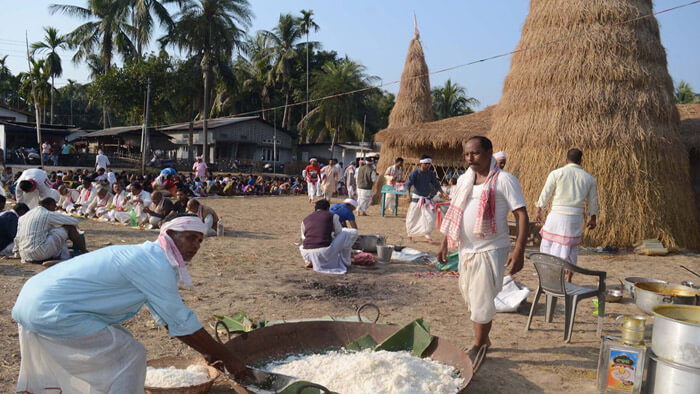
Menfolk, more particularly young men go to the field, preferably near a river, build a makeshift cottage called Bhelaghar that is made of hay from the harvest fields. During the night of the festival, they gather near Bhelaghar and prepare food for the community feast. They eat ‘bhaat’ with ‘dal’ (lentils), with ‘masor jul’ (fish curry), with ‘mangso’ (meat curry) or ‘xaak’ and ‘bhaji’ (herbs and vegetables). The food is mostly non-spicy and is usually prepared in earthenware. They exchange greetings sweets to celebrate the festival. The entire Uruka night is spent around a Meji where people perform Bihu dance, sing Bihu songs with dhol beating, and play games.
Suggested Read: Culture and Tradition of Assam
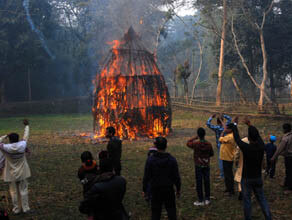
The next morning they take bath and gather around the Bhelaghar to burn it called ‘Meji’. People gather around the Meji and throw Pithas (rice cakes) and betel nuts to it while burning it at the same time. They offer prayer to the Fire God and come back home with half burnt firewood for being thrown among fruit trees. Community fishing by the tribes in the large wetlands can also be seen.
Different types of sports like Buffalo-fight, Egg-fight, Cock-fight, Nightingale-fight are held throughout the day. This can also be observed in the Baishakhi festival and Pongal of South India. There are other conventional festivals observed by various ethnic-cultural groups. Me-dam-me-phi, Ali-aye-ligang, Porag, Garja, Hapsa Hatarnai, Kherai are a few among them. The Uruka comes on 13 January followed by the Bihu on 14 January.
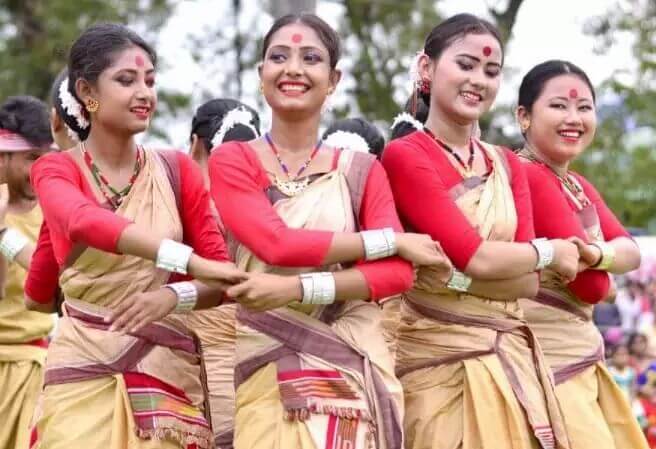
Every year during the Magh Bihu/Bhogali Bihu, Brahmaputra Beach Festival is also organized by the Assam Boat Racing and Rowing Association. It is a platform to celebrate the indigenous culture of the state through traditional sports, cultural events, and performances.
The festival offers a perfect blend of the traditional contest, like elephant race, kite flying, modern adventure sports like wind surfacing, rafting, canoeing kayaking, para-dropping, hot air ballooning, beach volleyball and beach cricket, The festival gives a scintillating outdoor experience one can ever have. In the backdrop of the mighty Brahmaputra, the beach festival has its own charm. You get a more relaxed crowd and less general chaos. Plus, there is great food.
